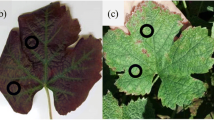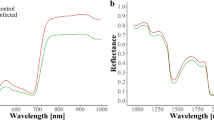Abstract
Disease detection by means of hyperspectral reflectance is inevitably influenced by the spectral difference between foreside (adaxial surface) and backside (abaxial surface) of a leaf. Taking yellow rust disease in winter wheat as an example, the spectral differences between the foreside and backside of healthy and diseased wheat leaves at both jointing stage and grain filling stage were investigated based on spectral measurements with a large sample size. The spectral difference between leaf orientations was found to be confused with disease signals to some extent. Firstly, the original bands and spectral features (SFs) that were sensitive to the disease were identified through a correlation analysis. Then, to eliminate the influence of leaf orientation, a pairwise t test was used to screen for the orientation insensitive bands and SFs. By conducting an overlapping procedure, the bands/SFs that were sensitive to the disease yet insensitive to the leaf orientations were selected and tested for disease detection. The results suggested that the Ref525–745 nm, Ref1060–1068 nm, DEP920–1120, DEP1070–1320, AREA1070–1320, SR and NDVI at the jointing stage, and the Ref606–697 nm, Ref740–752 nm, WID550–770, SR, NDVI, GNDVI, RDVI, GI and MCARI at the grain filling stage were capable of eliminating the influence of leaf orientation, and were retained for disease detection. Given these features, models based on the partial least square regression analysis showed a better performance at the grain filling stage, with the R 2 of 0.854 and RMSE of 0.104. This result indicated that reliable estimation of disease severity can be made until the grain filling stage. In the future, more attention should be given to leaf orientation when detecting disease at the canopy level.








Similar content being viewed by others
References
Akaike, H. (1974). A new look at the statistical model identification. IEEE Transactions on Automatic Control, 19(6), 716–723.
Baret, F., & Guyot, G. (1991). Potentials and limits of vegetation indices for LAI and APAR assessment. Remote Sensing of Environment, 35(2–3), 161–173.
Bravo, C., Moshou, D., West, J., McCartney, A., & Ramon, H. (2003). Early disease detection in wheat fields using spectral reflectance. Biosystems Engineering, 84(2), 137–145.
Burnham, K. P., & Anderson, D. R. (2002). Model selection and inference: a practical information-theoretic approach. New York: Springer.
Chen, L., Huang, J. F., Wang, F. M., & Tang, Y. L. (2007). Comparison between back propagation neural network and regression models for the estimation of pigment content in rice leaves and panicles using hyperspectral data. International Journal of Remote Sensing, 28(16), 3457–3478.
Curran, P. J. (1989). Remote sensing of foliar chemistry. Remote Sensing Environment, 30(3), 271–278.
Devadas, R., Lamb, D. W., Simpfendorfer, S., & Backhouse, D. (2009). Evaluating ten spectral vegetation indices for identifying rust infection in individual wheat leaves. Precision Agriculture, 10(6), 459–470.
Fensholt, R., & Sandholt, I. (2003). Derivation of a shortwave infrared water stress index from MODIS near-and shortwave infrared data in a semiarid environment. Remote Sensing of Environment, 87(1), 111–121.
Gao, B. C. (1996). A normalized difference water index for remote sensing of vegetation liquid water from space. Remote Sensing of Environment, 58(3), 257–266.
Gitelson, A. A., Kaufman, Y. J., & Merzlyak, M. N. (1996). Use of green channel in remote sensing of global vegetation from EOS–MODIS. Remote Sensing Environment, 58(3), 289–298.
Gong, P., Pu, R., & Heald, R. C. (2002). Analysis of in situ hyperspectral data for nutrient estimation of giant sequoia. International Journal of Remote Sensing, 23(9), 1827–1850.
Graeff, S., Link, J., & Claupein, W. (2006). Identification of powdery mildew (Erysiphe graminis sp. tritici) and take-all disease (Gaeumannomyces graminis sp. tritici) in wheat (Triticumaestivum L.) by means of leaf reflectance measurements. Central European Journal of Biology, 1(2), 275–288.
Huang, W. J., David, W. L., Niu, Z., Zhang, Y. J., Liu, L. Y., & Wang, J. H. (2007). Identification of yellow rust in wheat using in situ spectral reflectance measurements and airborne hyperspectral imaging. Precision Agriculture, 8(5), 187–197.
Huang, M. Y., Huang, W. J., Liu, L. Y., Huang, Y. D., Wang, J. H., Zhao, C. J., et al. (2004). Spectral reflectance feature of winter wheat single leaf infected with stripe rust and severity level inversion. Transactions of the CSAE, 20(1), 176–180. (in Chinese with English abstract).
Huang, W. J., Huang, M. Y., Liu, L. Y., Wang, H., Zhao, C. J., & Wang, J. D. (2005). Inversion of the severity of winter wheat yellow rust using proper hyperspectral index. Transactions of the CSAE, 21(4), 97–103.
Jiang, J. B., Chen, Y. H., & Huang, W. J. (2007). Using hyperspectral derivative index to monitor winter wheat disease. Spectroscopy and Spectral Analysis, 27(12), 2475–2479. (In Chinese with English abstract).
Li, G. B., Zeng, S. M., & Li, Z. Q. (1989). Integrated management of wheat pests (pp. 185–186). Beijing: Press of Agriculture Science and Technology of China. In Chinese.
Lichtenthaler, H. K. (1987). Chlorophylls and carotenoids, the pigments of photosynthetic biomembranes. In R. Douce & L. Packer (Eds.), Methods enzymology 148 (pp. 350–382). NewYork: Academic Press Inc.
Merton, R., & Huntington, J. (1999). Early simulation of the ARIES-1 satellite sensor for multi-temporal vegetation research derived from AVIRIS. In summaries of the eight jpl airborne earth science workshop (pp. 299–307). Jet Propulsion Laboratory Publication, Pasadena, CA.
Merzlyak, M. N., Gitelson, A. A., Chivkunova, O. B., & Rakitin, V. Y. (1999). Non-destructive optical detection of pigment changes during leaf senescence and fruit ripening. Physiologia Plantarum, 106(1), 135–141.
Moshou, D., Bravo, C., Oberti, R., West, J., Bodria, A., McCartney, A., et al. (2005). Plant disease detection based on data fusion of hyper-spectral and multi-spectral fluorescence imaging using Kohonen maps. Real-Time Imaging, 11(2), 75–83.
Moshou, D., Bravo, C., West, J., Wahlen, S., McCartney, A., & Ramon, H. (2004). Automatic detection of ‘yellow rust’ in wheat using reflectance measurements and neural networks. Computers and Electronics in Agriculture, 44(3), 173–188.
Naidu, R. A., Perry, E. M., Pierce, F. J., & Mekuria, T. (2009). The potential of spectral reflectance technique for the detection of grapevine leafroll-associated virus-3 in two red-berried wine grape cultivars. Computers and Electronics in Agriculture, 66(1), 38–45.
Peñuelas, J., Gamon, J. A., Fredeen, A. L., Merino, J., & Field, C. B. (1994). Reflectance indices associated with physiological changes in nitrogen- and water-limited sunflower leaves. Remote Sensing of Environment, 48(2), 135–146.
Pu, R., Foschi, L., & Gong, P. (2004). Spectral feature analysis for assessment of water status and health level in coast live oak (Quercus agrifolia) leaves. International Journal of Remote Sensing, 25(20), 4267–4286.
Pu, R., Ge, S., Kelly, N. M., & Gong, P. (2003). Spectral absorption features as indicators of water status in coast live oak (Quercus agrifolia) leaves. International Journal of Remote Sensing, 24(9), 1799–1810.
Roujean, J. L., & Breon, E. M. (1995). Estimating PAR absorbed by vegetation from bidirectional reflectance measurements. Remote Sensing Environment, 51(3), 375–384.
Rouse, J. W., Haas, R. H., Schell, J. A., & Deering, D. W. (1973). Monitoring vegetation systems in the great plains with ERTS. Third ERTS symposium (pp. 309–317). NASA SP-351, NASA, Washington, DC.
Salazar, L., Kogan, F., & Roytman, L. (2008). Using vegetation health indices and partial least squares method for estimation of corn yield. International Journal of Remote Sensing, 29(1), 175–189.
Strange, R. N., & Scott, P. R. (2005). Plant disease: a threat to global food security. Annual Reviews Phytopathology, 43, 83–116.
Takahashi, K., Mineuchi, K., Nakamura, T., Koizumi, M., & Kano, H. (1994). A system for imaging transverse distribution of scattered light and chlorophyll fluorescence in intact rice leaves. Plant Cell and Environment, 17(1), 105–110.
Weng, Q. H. (2011). Advances in environmental remote sensing. In R. L. Pu & P. Gong (Eds.), Hyperspectral remote sensing of vegetation bioparameters (Chapter 5). Boca Raton: CRC.
Xu, H. R., Ying, Y. B., Fu, X. P., & Zhu, S. P. (2007). Near-infrared spectroscopy in detecting leaf miner damage on tomato leaf. Biosystems Engineering, 96(4), 447–454.
Yang, C. M., Cheng, C. H., & Chen, R. K. (2007). Changes in spectral characteristics of rice canopy infested with brown plant hopper and leaf folder. Crop Science, 47(1), 329–335.
Zarco-Tejada, P. J., Berjón, A., López-Lozano, R., Miller, J. R., Martín, P., Cachorro, V., et al. (2005). Assessing vineyard condition with hyperspectral indices: leaf and canopy reflectance simulation in a row-structured discontinuous canopy. Remote Sensing Environment, 99(3), 271–287.
Zhang, J. C., Pu, R. L., Wang, J. H., Huang, W. J., Yuan, L., & Luo, J. H. (2012). Detecting powdery mildew of winter wheat using leaf level hyperspectral measurements. Computers and Electronics in Agriculture, 85, 13–23.
Zhao, C. J., Huang, M. Y., Huang, W. J., Liu, L. Y., & Wang, J. H. (2004). Analysis of winter wheat stripe rust characteristic spectrum and establishing of inversion models. In R. King & M. Datcu (Eds.), Proceedings of Geoscience and Remote Sensing Symposium (vol. 6, pp. 4318–4320). Alaska, USA.
Zhou, Q. F., & Wang, J. H. (2002). Comparison of adaxial and abaxial surface reflectance under different nitrogen level. Transactions of the CSAE, 18(9), 34–39.
Acknowledgments
This work was subsidized by Beijing Natural Science Foundation (4132029, 4122032), National Natural Science Foundation of China (41271412, 41101395) and National Key Technology R&D Program (2012BAH29B02). The authors are grateful to Mr. Weiguo Li and Mrs. Hong Chang for data collection.
Author information
Authors and Affiliations
Corresponding author
Rights and permissions
About this article
Cite this article
Yuan, L., Zhang, JC., Wang, K. et al. Analysis of spectral difference between the foreside and backside of leaves in yellow rust disease detection for winter wheat. Precision Agric 14, 495–511 (2013). https://doi.org/10.1007/s11119-013-9312-y
Published:
Issue Date:
DOI: https://doi.org/10.1007/s11119-013-9312-y




